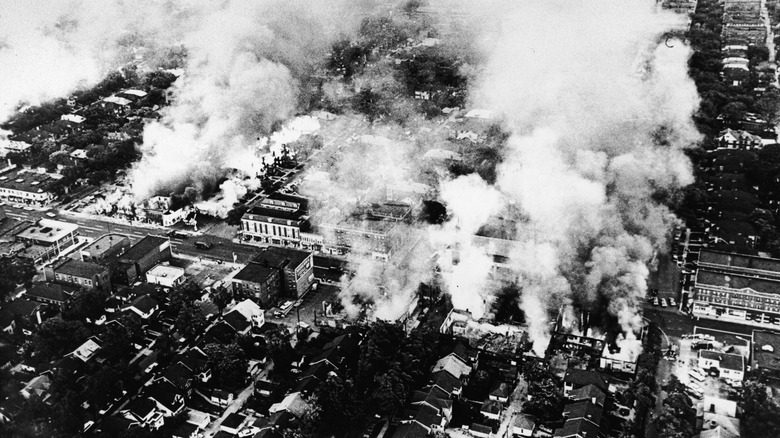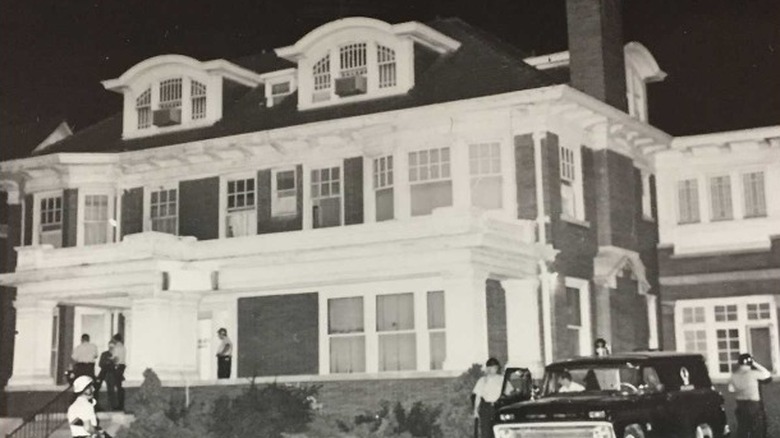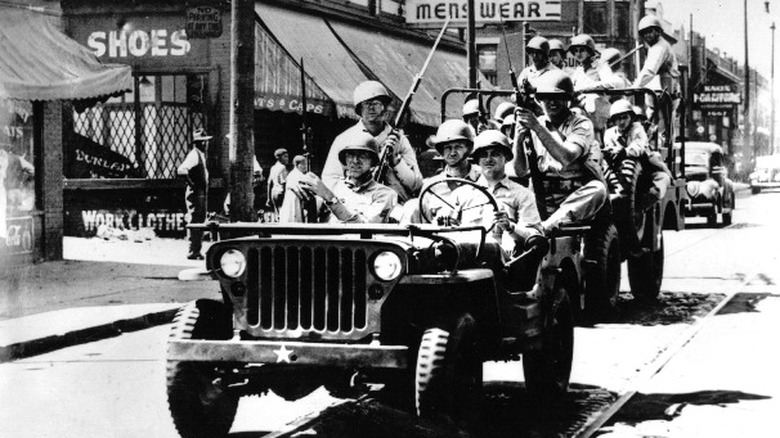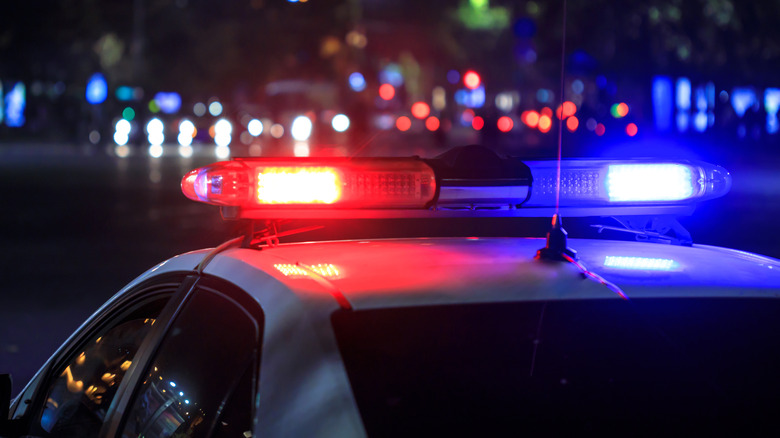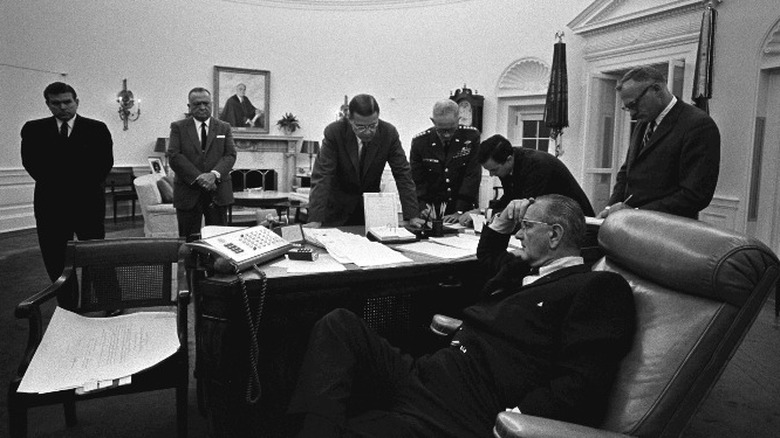The Truly Horrific Crime Scene Of The Algiers Motel Murders
In the late 1960s, Detroit, Michigan, began experiencing a devastating economic downturn, which was driven by the decline of the city's automotive industry. The Gilder Lehrman Institute of American History reports Detroit's automotive manufacturing plants employed more than 130,000 people at their peak. However, as the plants began leaving the city for the suburbs, and automation replaced many of the remaining jobs, the city began experiencing widespread unemployment.
At the same time, Detroit was experiencing increased tensions between its black residents and the predominantly white police department. As reported by History, much of the racial tension was occurring in the Virginia Park neighborhood, which was a predominantly black community. The neighborhood, which was on 460 acres of land, had nearly 60,000 residents, who had little or no income and were living in small, dilapidated homes or apartment complexes. Complaints of police brutality and racial profiling were essentially ignored, and the lack of oversight was blamed on the police department's lack of diversity. At the time, History reports, there were fewer than 50 Black officers on the force.
The increasing tension eventually erupted into violent riots, which left 43 people dead and hundreds injured. However, as reported by The Washington Post, the brutal deaths of 17-year-old Carl Cooper, 19-year-old Aubrey Pollard, and 18-year-old Fred Temple gained nationwide attention and remain one of the most tragic events that occurred during the riots.
The Detroit riots lasted four days
The Detroit riots began in the early morning hours of July 23, 1967. As reported by History, an after-hours party honoring some local veterans was taking place at the office of the United Community League for Civic Action, and authorities planned to raid the establishment and arrest the attendees. The police presence outside the club, and the subsequent arrest of the 85 party attendees, drew the attention of an estimated 200 onlookers, who became increasingly unruly and began throwing glass bottles. When one of the bottles struck the window of a police vehicle, History reports, the officers fled the scene. In the ensuing hours, several thousand people took to the streets. In addition to breaking into and looting local businesses, the rioters eventually began setting fires.
According to History, the riot grew to encompass a 100-block area around the Virginia Park neighborhood. Although 300 state troopers and the National Guard joined the Detroit Police Department in their efforts to quell the riot, they were no match for the thousands of people who had taken to the streets. As the rioting continued, President Lyndon B. Johnson approved Michigan's request for assistance, and nearly 2,000 Army troops were sent to Detroit to patrol the streets and restore order.
The riot lasted for four days, and the resulting damage was considerable. In addition to an estimated $50 million in property damage, 43 people were killed and nearly 5,000 were left homeless.
Amid the riots, authorities stormed the Algiers Motel annex
Detroit's Great Rebellions reports the Algiers Motel had a reputation for housing transients, who often included drug dealers and sex workers. In an attempt to expand their capacity, the motel owners purchased a large home, which was located directly behind the motel in the Virginia Park neighborhood. The home became part of the Algiers Motel and was referred to as "the annex."
In the midst of the riots, several residents of the Virginia Park neighborhood sought cover in the annex of the Algiers Motel. As reported by Michigan Day by Day, three days into the riot, on July 26, 1967, three teenagers were found dead inside the building.
That morning, 17-year-old Carl Cooper was reportedly standing on the annex's back porch with several friends shooting a starter pistol. Although it was loaded with blanks, the shooting was reported to authorities as legitimate gunfire. Several National Guardsmen, who were near the motel, also heard the gunfire and believed they were being targeted by a sniper. They subsequently contacted the Detroit Police Department and the dispatcher reported the incident as the Army being "under heavy fire." Detroit Under Fire reports that when the Detroit Police Department arrived on the scene, along with members of the National Guard, they fired at least 200 rounds at the house before storming inside. Carl Cooper was the first person shot and killed in the initial rush into the annex.
Detroit Police officers killed three teens inside the Algiers Motel annex
As reported by Detroit's Great Rebellions, 18-year-old Fred Temple was also shot by officers during their initial rush into the Algiers Motel annex. The circumstances surrounding the shootings of Cooper and Temple remain unclear, and controversial, as Temple did not have a weapon and the pistol Cooper fired from the balcony was never found. After searching the entire house for people and weapons, the officers lined up the annex occupants for questioning. A total of 10 people were taken into a hallway, where they were forced to lean, spread-eagle, against the wall.
According to Michigan Day by Day, the officers then took the people one by one into separate rooms, where they shot a gun at the floor around them in an attempt to get a confession. However, as few people were aware Cooper was shooting the pistol on the balcony, they were unable to provide the authorities with any information. Those who knew what happened were simply too frightened to give the authorities any information.
When it was his turn, 19-year-old Aubrey Pollard was taken into the same room where Temple was already shot dead. As reported by Michigan Day by Day, an officer on the scene said he shot Pollard in self defense when the teen pulled out a shotgun. However, The Washington Post reports the shotgun was never recovered from the scene.
The Detroit Police officers did not follow protocol
While waiting in the hallway, the suspects had no idea what was happening to their friends and acquaintances in the other rooms. As all they could hear were gunshots, they feared everyone was being shot and killed. In addition to using unconventional scare tactics, and actually killing three teens, The Washington Post reports one of the officers pistol-whipped another teen so hard that the impact broke the officer's rifle. Two of the suspects, who were women, were allegedly dragged down a staircase by the officers. They were then beaten and their clothing was forcibly removed. Detroit Under Fire reports the officers also used racial slurs when speaking and referring to the men and women in the annex.
As the situation escalated, the state police and National Guard officers left the annex. According to Michigan Day by Day, the Detroit police officers also left the scene, without reporting the injuries or shootings. As reported by Bridge Michigan, the officers were obligated, per protocol, to immediately report the shootings, contact the families of the deceased, and file their official reports detailing the particulars of the incident.
The officers who orchestrated the raid, who were eventually identified as Ronald August, Robert Paille, and David Senak, did not submit their official reports until several days later, and it was eventually determined that the details of the reports were falsified. It was also determined that the officers failed to follow protocol throughout and following the raid.
The officers were never convicted of killing the teens
As reported by WDET, U.S. Rep. John Conyers' field representative, Arthur Featherstone, said Conyers received a call from the owner of the Algiers Motel, who wanted to report his property was stormed and shot up by Detroit police officers, leaving three teenagers dead. Featherstone said he traveled to the motel, where he met several other state senators who wanted to see the scene for themselves. When describing the scene, Featherstone said, "It looked like something that goes on in Baghdad. Blood, everything shot up, tumbled up, bodies ... I'm still sick."
Detroit Under Fire reports autopsies performed on Carl Cooper, Aubrey Pollard, and Fred Temple, revealed all three of the teens were in "non-aggressive postures" when they were killed. It was also determined that they were all shot at close range.
In their reports, the Detroit police officers claimed the teens were already wounded when they arrived at the annex. They also said they called an ambulance for the teens before they left the scene. However, Patrolmen Ronald August eventually confessed he shot and killed Pollard, and Officer Robert Paille admitted to killing Temple. Although Officer Paille was charged with the murder of Temple and August was charged with the murder of Pollard, Detroit Under Fire reports Paille's confession was ultimately ruled to be inadmissible and the charge was dismissed. August was acquitted, as the jury believed his claims of self defense. Nobody has ever been charged in Cooper's death.

